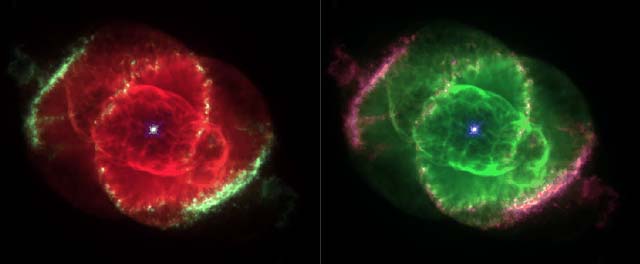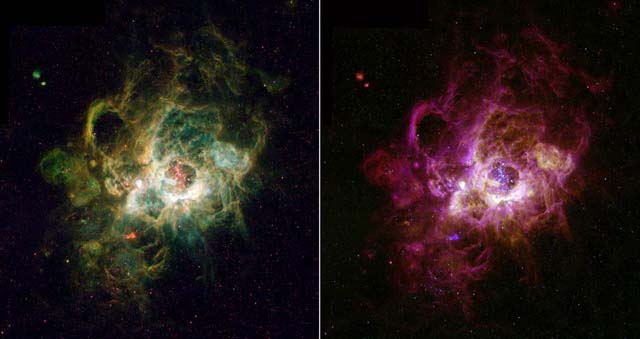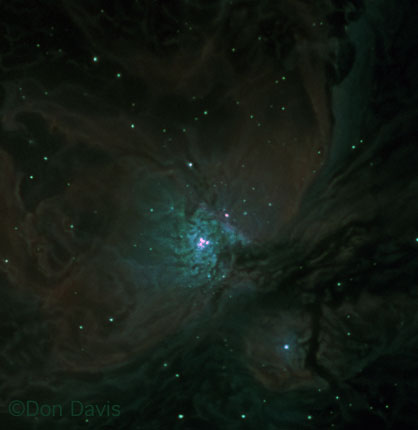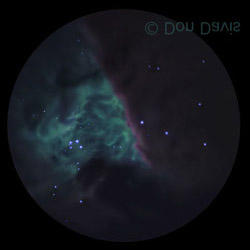 Color in the deep sky
Color in the deep sky Color in the deep sky
Color in the deep sky
The image to the right is typical
of the work of David Malin, master of large telescope astrophotography,
using Red, Green, and Blue filtered exposures to construct a 'natural
color' picture. Just what 'natural' color really consists of can
be debated however I am using the term as in how closely it comes
to what an imager similar to the human eye would see, although
in the case of deep sky objects this ideal is combined with the
assumption of enhanced light gathering power. If we had eyes several
meters across dim natural colors would emerge from the Milky Way
which appears to standard human eyes as a colorless feeble band
amid the stars.
Following are some observations and opinions and on how color is treated, and at times debatably mistreated, in some space photography.
I am grateful for reviews and advice on this material.
The Hubble is the greatest leap in seeing the Universe in visual wavelengths since Galileo. Rarely, however, are RGB color pictures made with Hubble. I do not wish to criticize the excellent work that is being done so much as to lament that RGB images of deep sky objects are rarely considered worth obtaining. There are things we also can learn in those wavelengths with better coorelation available to existing groundbased photography. I realize part of the advantage of having a space telescope is access to wavelengths you can't study from the ground, but at least as compelling an advantage is the big gain in resolution over the familiar views of astronomical objects. Part of the bridge between the familiar and the revelatory is seeing the image as we have known it transferred from a very defocused prelude to the 'real thing' in its full detail. The obscure wavelengths ususlly emphasized in their studies have information to give that maximizes the advantage of high resolution optics above the atmosphere.
Although the captions in photo releases generally declare the differences between the presented and true colors, only those familiar with the colors of the skies through experience are likely to catch such stylization without such disclaimers, which are often not relayed when reproduced.
Some examples of misleading color
images using arbitrary rather than true colors: 
This HST photo is of NGC 6543, the 'Cat's eye' nebula. It is located near the North Ecliptic pole, and is among the brighter of the so-called 'Planetary nebulae'.
The initially released version is at the left. To the right is my attempt to 'bring back' something closer to the actual colors as can be photographed from ground based telescopes. The April 1995 Sky and Telescope Magazine features the initially released version on the cover, but on page 98 of that issue a ground based CCD image in 'enhanced color' by Bruce Balick shows this object in a color scheme nearly the 'inverse' of the Hubble image. NGC 6543 also appears greenish in older color film images. A later version of the Hubble image reprocessed by Mr. Balick better suggests the telescopic colors, and can be seen at his site. Balick's revised HST image appeared on the October 1998 cover of Sky and Telescope. Subsequent releases of this object have shown advancements in conveying wide ranges of brightness and can be further compared with natural color images from new technology ground based telescopes. .Admittedly the beauty of the many Hubble image products, especially of Planetary nebulae, are so revaletory that this commentary should be considered a kind of 'addendum' rather than as direct critiscism. The data is rich enough to rework at will at ones leisure, as I have done here.
Here we see the celebrated photo of the dark pillars within the 'Eagle Nebula', as released and with an attempt at color reconstruction based on low resolution Earth based material. I hope this area is given a 'panoramic mosaic' treatment sometime in the final lease of life provided by the last servicing mission.

Here is the emission nebula NGC 604, in the nearby galaxy M33, the furthest galaxy visible to some unaided eyes. At left is the original green version, to the right is my attempt at reconstructing the true color. Since the spectral wavelengths used in such photos are not RGB oriented, such attempts at reconstructed color are approximate but much closer to the real thing than the initial releases. The Hubble Heritage Project has attempted to address this issue with later versions of Hubble releases 'remixed' to approximate ground based results.
Observing the brightest deep sky objects through a large aperture telescope can just begin to show the colors in a few of these, although most of the time in larger telescopes one can at best just distinguish bright reflection nebulae from emission nebula as different tinted faint grays, and only when seen adjacently.
 Since
the emission nebulae have a prominent emission line near the peak
of the
Since
the emission nebulae have a prominent emission line near the peak
of the
eye's response in the green, that color visually appears in the
brightest such nebulae. Usually reflection nebula appear a more
neutral gray. A few objects such as the Orion nebula are bright
enough to just begin to stimulate color vision in a large telescope.
On the right is my impression of the colors visible in a 24 inch
telescope, processed from a painting inspired by a Malin photograph.
Somewhat more detail is shown than can be visually distinguished
except as glimpses along the peripleral vision. Most
people can distinguish the green of the 'core' regions, but the
other reddish hues of the excited nebula as distinct from the
duller and bluer 'starlit' nebula are faint and only readily visible
through large telescopes. I have thought they were just detectable
through a 10 inch, but this is qualified by a quirk of the human
eye which causes color afterimages of the bright green areas to
'wash over' adjacent darker areas with the complimentary 'red'
color. There is also a mental image of what we are seeing based
on photographs which can influence ones impression.

At the left is a drawing based on a visual impression of the view through the Mt. Wilson 60 inch reflector, which gathers just enough light to allow the color vision to be stimulated by the brightest 'highlights' of the red parts of the nebulae facing the inner cluster of stars loosely scattered near the 'Trapezium'. quartet of very blue stars. The color of the green blue inner nebula is obviouis even in much smaller telescopes.